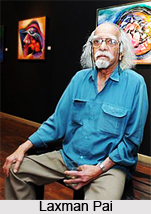 Laxman Pai was born on January 21, 1926 in Margao in Goa. He received his art education in Sir J. J. School of art in Mumbai where he was awarded the prestigious Mayo medal. He is recipient of three Lalit Kala national awards (1961, 1963 & 1972) and has been awarded the prestigious Padma Shri by the government of India in 1985. He was honoured by government of Goa in 1987 and awarded the Nehru award in 1995. Laxman Pai was principal of college of art in Goa from 1977-87.
Laxman Pai was born on January 21, 1926 in Margao in Goa. He received his art education in Sir J. J. School of art in Mumbai where he was awarded the prestigious Mayo medal. He is recipient of three Lalit Kala national awards (1961, 1963 & 1972) and has been awarded the prestigious Padma Shri by the government of India in 1985. He was honoured by government of Goa in 1987 and awarded the Nehru award in 1995. Laxman Pai was principal of college of art in Goa from 1977-87.
Laxman Pai`s style was influenced by designs he was commissioned to do for execution on porcelain. He has a strong bent toward the lyrical, with emphasis on delicate and expressive line. His had experimented with abstract form also. He chose to give a visual interpretation, through colour and variety of lines, to the moods of the music as determined by the vibrations of the notes. His works speak of a visual poetry with a happy blend of tradition and modernity, of reality, of technical perfection and enthusiasm. Bright colours and strong lines create an unsentimental lyricism in his works.
Laxman Pai belongs to the same early period of modern Indian and Goan art. Probably it was he who discovered the miniature style of painting that gave him a language to develop his own personal dialect. His style showed no preoccupation with colour, form on structure. Fancy and creative draughtsman ship has played an important part in his initial decorative detailed style. His images are generally graphic and representative of his fantastic excursions. His style is whimsical yet eclectic and serious in character.
Pai is strongly attached to his environment. He constantly returns to his native land for symbols of expression. Initially he did portray the simple life of his native land. Western ideologies redefined his earlier style, giving it a stylized discipline with greater attention to geometry and ornate details. The imagery, however, continued to be Goan.
His initial interest in costume and details has evolved to perfect which indicates a spiritual evolution of the artist. He carries the Hindu metaphor of Purusha-prakriti to new imaginative horizons in his creations.
He has more than one hundred solo exhibitions to his credit including nine in Paris, where he worked for ten years (1951-61). His other exhibitions have been held in London, Munich, Stuttgart, Bremen, New York, San Francisco, Bangkok, Kuala Lumpur, Singapore, New Delhi, Mumbai, Kolkata and Goa. Laxman Pai also participated in Bribable San Paulo, Brazil.
 Collection
Collection
# Ben & Abbey Grey Foundation, USA.
# New York Public Library.
# Berlin Museum, Germany.
# Museum of Modern Art, Paris.
# Madras Museum.
# Nagpur Museum.
# New York Library.
# National Gallery of Modern Art, New Delhi.
# Punjab University Museum.
Awards Received by Laxman Pai:
# 1947 Received Mayo Medal.
# 1961, 63, 72 National Award, Lalit Kala Akademi.
# 1972 National Award, Kangra Portraits Show, New Delhi.
# 1985 Awarded Padma Shri, Govt. of India.
# 1987 Honored by Govt. of Goa.
# 1995 Nehru Award, Goa.



















